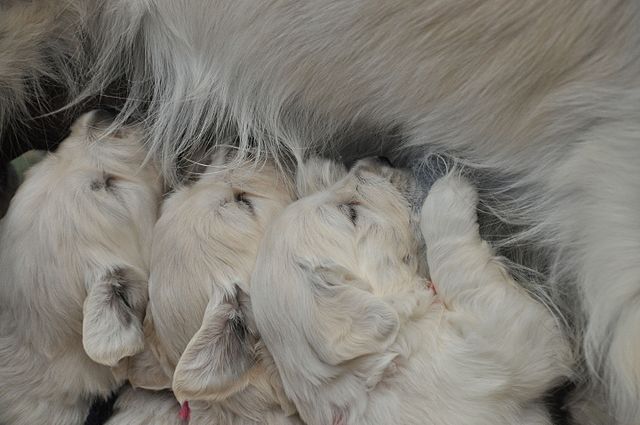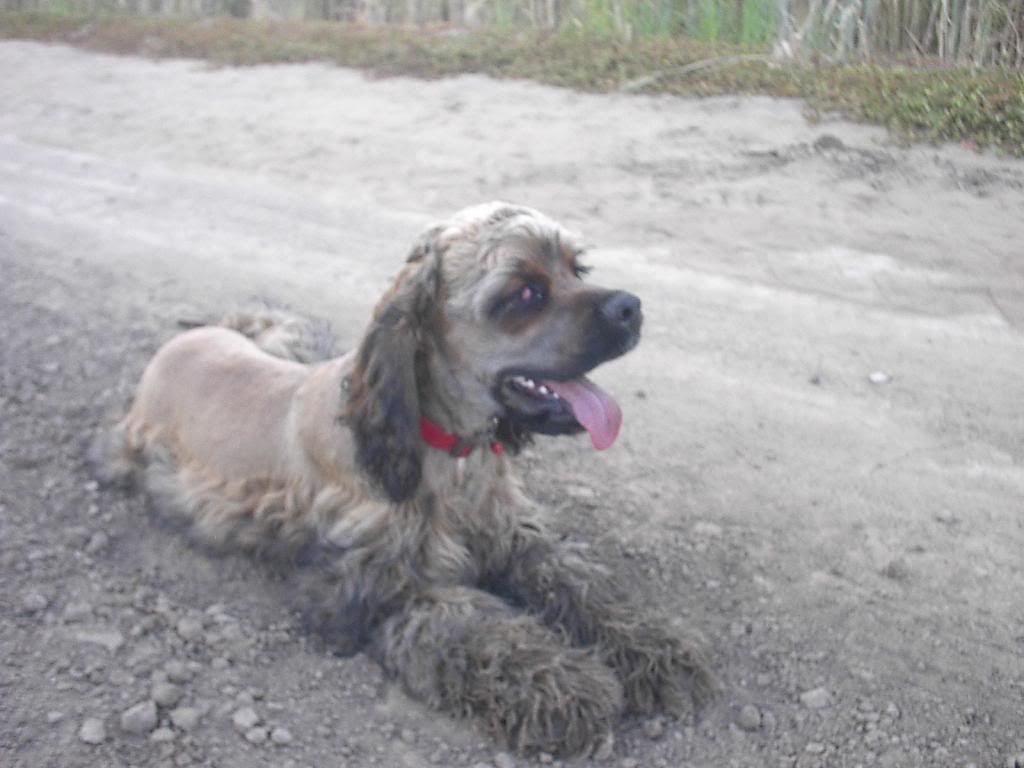 |
| A litter of Golden Retriever puppies, via Wikipedia. |
The younger the reproductive system, the less stress it puts on the body of the animal. The older the reproductive system, the less offspring, the harder it is on the mother, and there is a higher chance that the offspring will not survive or will be born defective (such as walrus puppies in dogs, though there are certainly other factors, it is believed that old age is one). When the dog is young, its body is thriving. It actually puts less stress on the dog to whelp at 6 months than at 2 years old. At 6 months the dog is receiving and absorbing a lot of nutrition, at 2 years it is fully mature and needs nutrients to sustain itself.
Horses are typically bred at 2 years old, this is when you can also safely ride them without having to worry about them getting sway backed from the added weight. However, horses in the wild will breed within their first season, but they often lose the foal due to inadequate nutrition and other environmental conditions (like stress). Captive horses bred young end up being smaller and their offspring will be smaller, because they weren't finished growing and had to put the nutrients they obtained into their offspring as opposed to their own body. This doesn't have a negative affect on the horse as a whole though, it's just aesthetics.
The recommended age for breeding goats is 1 year old, but some also feel this is too old. The longer you let a goat go without being bred the more likely they are to develop cancer and other lovelies, so it is recommended that if you aren't going to breed your doe that you get them spayed to prevent these risks. Goats bred too young also tend to be smaller, in fact they can be very very small if bred very young, but they have no issue taking care of their kids. Industrial farmers or raisers who pasture their goats and kids with a buck typically do not breed at any specific age, they just let nature take its course.
Rats and mice are pretty much exempt from the age breeding rule, being that they only live 1-2 years (mice) and 3-4 years (rats, though most die at 2 years from environmental causes).
Rabbits, pet breeders wait to breed until 1 year, meat breeders breed them at 6 months. Neither age seems to affect the size of the animal, and it does not affect mortality/chance of survival for litters. Breeding past age 5 yields smaller litters, but the doe's can still adequately care for their offspring.
Based on the breeding guidelines and results for these animals, it seems the only detrimental thing about breeding young is that the animal will be smaller when a fully grown adult.
Even stray dogs on the streets breed on their first heat and may even breed back to back, it depends on food/resources and their chances of finding a mate (which is very high). The older they get however, the more likely their pups will die because the mother can't take care of them, or that the mother will die because she doesn't have the strength to push them out. The opposite has never been true. If they were not meant to breed at 6 months old, mother nature would not have allowed them to breed at 6 months old. Simple as that. If your dog is going to die from being bred so "young", then perhaps you shouldn't be breeding it, as if you didn't exist, your dog would die and cease to exist from the world.
If you produce genetically defective offspring, you can spend more time test breeding them and still have time left over to produce healthy offspring. If you breed at 2 years old, when the dog has proven themselves, you have far less time to do any test breeding's. Even more, who is going to spend a whole bunch of money purchasing, showing, and testing a dog, and then stop breeding them when they produce defective offspring? That would be ludicrous. Maybe this is the real problem in pedigreed dogs, breeding at 2 years old. I say a dog should prove itself through healthy offspring first before going on to be titled in anything.
MYTH: a dog cannot be proven as healthy until they are 2 years old. I purchased a Toy Poodle named Belle who started showing y suture cataracts at 4 months old. She was pretty much completely blind before she was even a year old. I have purchased numerous American Cockers who have popped cherry eyes at 6 months old. If CERF can't even detect that, then there is something very wrong there. More importantly, health testing only guarantees that that dog is healthy at that time, there is always the possibility that the dog will develop health problems later on in life, like cancer. That isn't to say that, you shouldn't do it, but it certainly shouldn't be treated as "my dog is 100% healthy, I have the tests to prove it", it doesn't guarantee the health of the parent OR the offspring, it just helps rule defects out so you don't breed a defective dog. Again, the dog can always come up with healh issues later on, or even be recessively carrying the health issue that will pop up in their resulting offspring.
 |
| Tucker, one of many American Cocker Spaniels with cherry eyes... He underwent surgery shortly after this photo was taken. |
MYTH: giant breeds are still maturing, even at 2 years. Actually, the reason giant breeds have such a short life span is because of accelerated aging. Breeding them "young" might actually prolong their life (because it stunts growth)!
I've also seen a lot of people say "Would you let an 11 year old child have a baby!" Actually, there are 11 year olds who have babies.... There are even girls far younger than 11 who have given birth. It's just our "civilized" society has tabooed it, even made it illegal, because it is "wrong". Not that I would allow my 11 or younger year old daughter get pregnant and have a baby, but if I was in another country where things like that happen all the time, I probably wouldn't have a problem with it. In those countries the girl is taken in by a wealthy man/family where she is taken care of very well, I wouldn't have to worry or take care of her like I would here in the US. This is probably the reason why it is taboo, at the age of 18 a woman should be able to take care of herself (so if she gets pregnant, the responsibility doesn't fall on her family), and that is why it is considered the adult age and women at this age can have sex with a man of any age without him being prosecuted.
The only dogs I might recommend breeding at two years old are extremely small breeds like Chihuahua's, they're probably going to need a cesarean section even at 2 years old, but at 6 months old it is pretty much guaranteed. If you can breed any Chihuahua at 6 months old and not need a cesarean section, for the love of god breed it like wild fire (it's unheard of). Even older would be breeds like the Cavalier King Charles Spaniel which I would breed at 5 years and older with heart murmur testing, because this is one of the leading causes of death in the breed (it causes an enlarged heart which causes early death/heart failure). Besides dogs like these though, I would breed at 6 months to a year, whichever you're more comfortable with or that you feel might better suit your dog.











